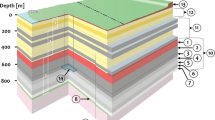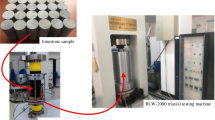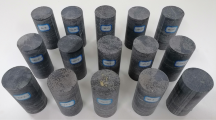Abstract
Lindsay Limestone is an argillaceous limestone encountered in Southern Ontario, Canada. The Lindsay formation is regarded as a suitable geologic medium for the construction of a Deep Geologic Repository for storing low to intermediate level nuclear waste. The Lindsay Limestone is a nodular argillaceous rock with very low permeability, requiring the use of hydraulic pulse tests for the measurement of its permeability characteristics. The paper describes the triaxial testing facility, the theoretical basis for the test and the procedures used to analyze the experimental results for estimating the permeability of the Lindsay Limestone. The results are compared with the data available in the literature.









Similar content being viewed by others
References
Alonso E, Gens A, (eds) (2002) Key issues in waste isolation research. Eng Geol 64:89–316
Alonso EE et al (2005) The FEBEX benchmark test: case definition and comparison of modelling approaches. Int J Rock Mech Min Sci 42:611–638
Armand G, Su K (2006) Hydromechanical coupling phenomena observed during a shaft sinking experiment in a deep argillaceous rock. Proc GeoProc 2006, Nanjing, pp 725–731
Banks D, Odling NE, Skarphagen H, Rohr-Torp E (1996) Permeability and stress in crystalline rock. Terra Nova 8:223–235
Barenblatt GI, Entov VM, Ryzhik VM (1990) Theory of fluid flows through natural rocks. Kluwer, Dordrecht
Bear J (1972) Dynamics of fluids in porous media. American Elsevier, New York
Bernabé Y (1986) The effective pressure law for permeability in Chelmsford Granite and Barre Granite. Int J Rock Mech Min Sci 23:267–275
Bernabé Y (1987) A wide range permeameter for use in rock physics. Int J Rock Mech Min Sci 24:309–315
Brace WF, Walsh JB, Frangos WT (1968) Permeability of granite under high pressure. J Geophys Res 73:2225–2236
Chapman NA, McKinley IG (1987) The geological disposal of nuclear waste. Wiley, New York
David C, Wong T-F, Zhu W, Zhang J (1994) Laboratory measurement of compaction-induced permeability change in porous rocks: Implications for the generation and maintenance of pore pressure excess in the crust. Pure Appl Geophys 143:425–456
Gartner Lee Ltd (2008) DGR supporting technical report: phase I geosynthesis. OPG 00216-REP-01300-00010-R00 (DOC 556)
Gnirk P (1993) OECD/NEA International Stripa Project Overview—Natural Barriers. SKB, Stockholm
Golder Associates (2003) Low level waste geotechnical feasibility study—Western Waste Management Facility Bruce Site, Tiverton, Ontario. Report to Ontario Power Generation
Gray MN (1993) OECD/NEA International Stripa Project Overview, vol III: Engineered Barriers. SKB, Stockholm
Gross J, Scherer GW (2003) Dynamic pressurization: novel method for measuring fluid permeability. J Non-Crystalline Solids 325:34–47
Heidland J (2003) Laboratory testing of coupled hydro-mechanical processes during rock deformation. Hydrogeol J 11:122–141
Horseman ST (2001) Self-healing of fractures in argillaceous media from the geomechanical point of view. In: Self-healing topical session. Proceedings of 11th Clay Club Meeting, Nancy. OECD/NEA, Paris, pp 19–25
Hoteit N, Su K, Tijani M, Shao J-F (eds) (2002) Hydromechanical and thermohydromechanical behaviour of deep argillaceous rock-theory and experiments. Proceedings of international workshop on geomechanics. Paris A.A. Balkema Publications Lisse, The Netherlands
Hsieh PA, Tracy JV, Neuzil CE, Bredehoeft JD, Silliman SE (1981) A transient method for determining the hydraulic properties of ‘tight’ rocks.—I. Theory. Int J Rock Mech Min Sci 18:245–252
Hueckel T, Peano A (eds) (1996) Thermo-mechanics of clays and clay barriers. Spec Issue Eng Geol 41:1–301
Huertas F et al (2000) Full-scale engineered barriers experiment for a deep geological repository for high-level radioactive waste in crystalline host rock. European commission nuclear sciences and technology, EUR 19147, Brussels
Intera Ltd (1988) Inventory and assessment of hydrogeologic conditions of underground openings in sedimentary rock. Representative of Ontario Hydro
Laughton AS, Roberts LEJ, Wilkinson D, Gray DA (1986) The disposal of long-lived and highly radioactive wastes. In: Proceedings of a Royal Society Discussion Meeting London, Royal Society, London
Maßmann J, Uehara A, Rejeb A, Millard A (2009) Investigation of desaturation in an old tunnel and new galleries at an argillaceous site. Environ Geol 57:1337–1345
Mazurek M (2004) Long-term used nuclear fuel waste management—geoscientific review of the sedimentary sequence in Southern Ontario. Technical Report TR 04-01, Institute of Geological Sciences, University of Bern, Switzerland
Millard A, Rejeb A (2008) Investigation of the hydro-mechanical in situ properties of Tournemire Argillite from the mine-by-test experiment. In: Shao J-F, Burlion N (eds) Thermo-hydromechanical and chemical coupling in geomaterials and applications. Proceedings of the third international symposium GeopProc’ 2008. Lille, France, pp 313–320
Neuzil CE, Cooley C, Silliman SE, Bredehoeft JD, Hsieh PA (1981) A transient method for determining the hydraulic properties of ‘tight’ rocks—II Application. Int J Rock Mech Min Sci 18:253–258
OECD (1988) Geological disposal of radioactive waste. In situ research and investigations in OECD countries. NEA OECD, Paris
OPG (2008) Ontario power generation’s deep geologic repository for low and intermediate level waste. Supporting technical report: phase 1-geosynthesis. OPG 00216-REP-01300-00010-R00
Philips OM (1991) Flow and reactions in permeable rocks. Cambridge University Press, Cambridge
Pusch R (ed) (1990) Artificial clay barriers for high-level radioactive waste repositories. Spec Issue Eng Geol 28:230–455
Raven K, Novakowski KS, Yager RM, Heystee RJ (1992) Supernormal fluid pressures in sedimentary rocks of southern Ontario–Western New York State. Can Geotech J 29:80–93
Selvadurai APS (ed) (1997) Hydro-thermo-mechanics of engineered clay barriers and geological barriers. Spec Issue Eng Geol 47:311–379
Selvadurai APS (2000) Partial differential equations in mechanics, vol 1. Fundamentals Laplace’s equation diffusion equation wave equation. Springer, Berlin
Selvadurai APS (2002a) Influence of pressurized water influx on the hygro-thermal behaviour of an engineered clay barrier in a waste emplacement bore hole. Eng Geol 64:157–178
Selvadurai APS (2002b) Some remarks on the elastic drive equation. In: Environmental geomechanics. In: Vulliet L, Laloui L, Schrefler BA (eds) Proceedings of the international workshop on environmental geomechanics, Monte Verita, Ascona. EPFL Press, Lausanne, pp 253–258
Selvadurai APS (2004) Stationary damage modelling of poroelastic contact. Int J Solids Struct 41:2043–2064
Selvadurai APS (2009) Influence of residual hydraulic gradients on decay curves for one-dimensional hydraulic pulse tests. Geophys J Int 177:1357–1365
Selvadurai APS, Carnaffan P (1997) A transient pressure pulse method for the measurement of permeability of a cement grout. Can J Civil Eng 24:489–502
Selvadurai APS, Głowacki A (2008) Permeability hysteresis of limestone during isotropic compression. Ground Water 46:113–119
Selvadurai APS, Nguyen TS (1996) Scoping analyses of the coupled thermal–hydrological–mechanical behaviour of the rock mass around a nuclear fuel waste repository. Eng Geol 47:379–400
Selvadurai PA, Selvadurai APS (2007) On cavity flow permeability testing of a sandstone. Ground Water 45:93–97
Selvadurai APS, Selvadurai PA (2010) Surface permeability tests: experiments and modelling for estimating effective permeability. Proc R Soc Math Phys Sci Ser A 466:2819–2846
Selvadurai APS, Boulon MJ, Nguyen TS (2005) The permeability of an intact granite. Pure Appl Geophys 162:373–407
Song I, Renner J (2006) Linear pressurization method for determining hydraulic permeability and specific storage of a rock sample. Geophys J Int 164:685–696
Suri P, Azeemuddin M, Zaman MM, Kukreti AR, Roegiers J-C (1997) Stress-dependent permeability measurement using the oscillating pulse technique. J Pet Sci Eng 17:247–264
Vilks P, Miller NH (2007) Evaluation of experimental protocols for characterizing diffusion in sedimentary rocks, atomic energy of Canada limited. Nuclear Waste Management Division Report TR-2007-11, Toronto
White FM (1986) Fluid mechanics, 2nd edn. McGraw-Hill, New York
Wong T, David C, Zhu W (1997) The transition from brittle faulting to cataclastic flow in porous sandstones: mechanical deformation. J Geophys Res 102:3009–3025
Zhu W, Wong T (1997) The transition from brittle faulting to cataclastic flow: permeability evolution. J Geophys Res 102:3027–3041
Acknowledgments
The work described in this paper was supported by a Strategic Research Grant awarded by the Natural Sciences and Engineering Research Council of Canada to the senior author. The authors are grateful to Mr. Mark Jensen and Dr. Ben Belfadhel of the Nuclear Waste Management Organization, Toronto, ON, for their interest in the research and to Dr. S. Stroes-Gascoyne for allowing access to results of MIP tests conducted at the AECL Laboratories, Pinawa, Man. The technical assistance of Mr. J. Bartczak, of the Environmental Geomechanics Laboratory at McGill University in developing the uses of the Sika sealant technique is acknowledged. The assistance of Mr. Nick Papanicolaou, Quarry Coordinator, St. Mary’s Cement, Bowmanville, ON, for providing the research program with the block samples of the Lindsay Limestone is also gratefully acknowledged.
Author information
Authors and Affiliations
Corresponding author
Rights and permissions
About this article
Cite this article
Selvadurai, A.P.S., Letendre, A. & Hekimi, B. Axial flow hydraulic pulse testing of an argillaceous limestone. Environ Earth Sci 64, 2047–2058 (2011). https://doi.org/10.1007/s12665-011-1027-7
Received:
Accepted:
Published:
Issue Date:
DOI: https://doi.org/10.1007/s12665-011-1027-7




